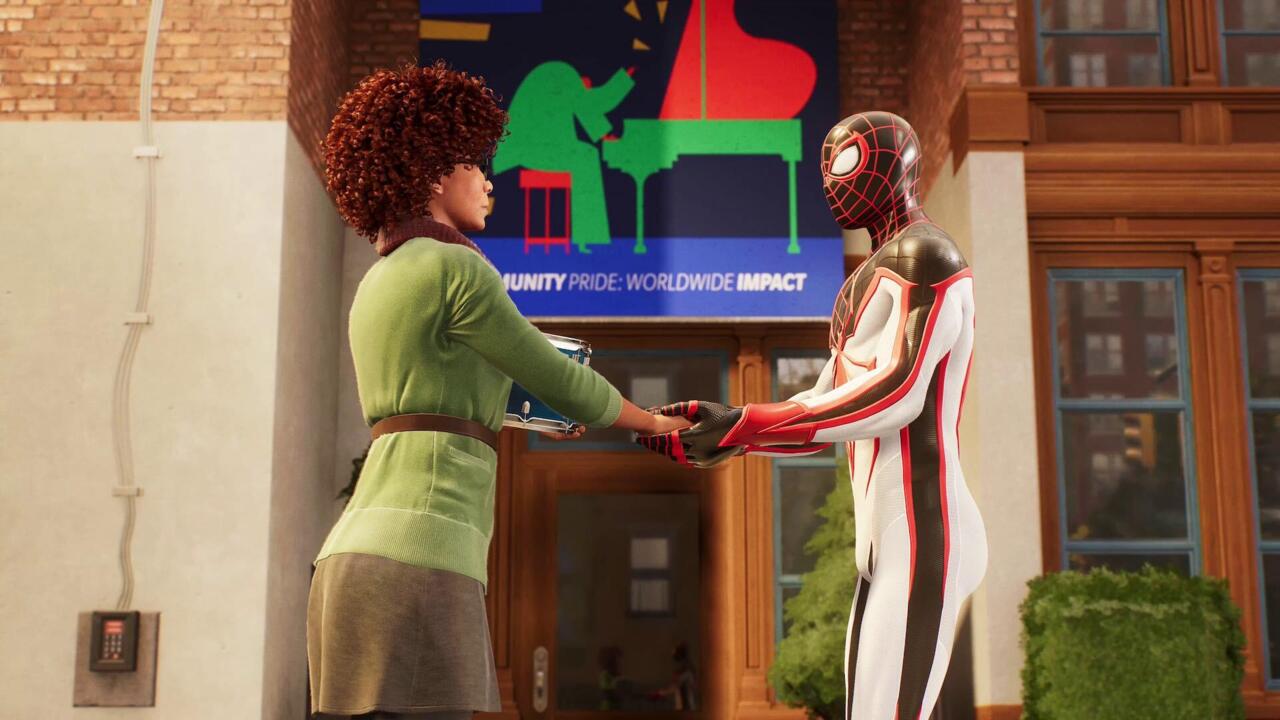At first glance, the trio of MLB The Show 23, Marvel’s Spider-Man 2, and Assassin’s Creed Mirage share very little in common. Sure, all three games launched in 2023, and both Spider-Man 2 and Assassin’s Creed Mirage feature dense open worlds, but other than what you might call broad similarities, they’re almost entirely disparate from one another. That is, except for one surprising commonality: They all taught me something new about the past.
From a packed ballpark in 1920s Kansas to the comic-book streets of New York City and a bustling ninth-century Baghdad, each game adopts a different approach toward educating its players on specific people, moments, and places from human history. When I look back on 2023–a year stacked with exceptional video games–this unlikely trio of AAA games stands out because of the various ways in which they use the art form to shine a light on underrepresented cultures and the pivotal impact they had on our history–doing so in a way only an interactive medium like video games can.
In MLB The Show 23, this takes the shape of a new mode called Storylines. Many sports games have ventured into the past before, but none have done so in such a lovingly crafted way as San Diego Studio’s ode to the Negro Leagues. Storylines is essentially a series of playable documentaries, with each one combining archival footage, eye-catching hand-drawn art, and the spellbinding narration of Bob Kendrick–president of the Negro League Baseball Museum–to explore the lives and careers of eight legendary baseball players from an era before Jackie Robinson broke the color barrier. It’s impossible to be a fan of baseball without knowing the story of Robinson and his iconic 42, but MLB The Show 23 taught me about other incredible players I knew next to nothing about, including Satchel Page, Hilton Smith, and Hank Thompson.

Each of the eight players is given a one- to two-hour documentary filled with reverence, striking attention to detail, and the gravitas needed to tell the enthralling story of people triumphing in the face of prejudice and hate. These documentaries are as much about sports history as they are about American history and the civil rights movement, giving these players the long-overdue recognition they deserve after being overlooked or completely forgotten due to segregation. Storylines doesn’t just give you a better understanding of who these people were either; it lets you experience why someone like Satchel Page was so transcendent.
Throughout each storyline, you’re given the chance to step onto the diamond and recreate notable moments from throughout each player’s career. The standout moment occurs during one of Satchel Page’s episodes, as Bob Kendrick weaves a tale about an instance where Satchel’s Kansas City Monarchs were playing against a semi-pro all-white team. After recording a hit off the flamethrowing righty in their first at-bat, the all-white team started directing racial epithets at Satchel amidst claims that he also wasn’t very good. In response, Satchel called his entire team in and made them sit around the mound to watch him pitch instead of fielding their positions. Such was his confidence that he dared the other team to get another hit, and they simply couldn’t–in fact, he struck out the side. Getting to recreate this moment is unlike anything else in the game, and its uniqueness speaks to Satchel Page’s enormous personality.
Spider-Man 2, on the other hand, takes a different approach to its historical veneration. Partway through the blockbuster sequel, protagonist Miles Morales is given a task by his mom, Rio, to help the curator of the Harlem Cultural Museum. She’s been locked out of the building when a donor arrives to pledge essential funds to keep it open. What initially seems like a reasonably low-stakes task–doing nothing more than lending the game a taste of that friendly neighborhood Spider-Man–quickly transforms into a questline that carries much more weight. As it turns out, the reason the curator was locked out of the museum is because it was being raided by a gang of thugs who made off with an impressive collection of jazz memorabilia. A series of missions follow as Miles attempts to recover the stolen instruments. The stakes never increase beyond this; it’s a questline that grounds the rest of the game and underlines how much Spider-Man means to the city of New York. Miles is also invested because he cares about his community, even when supervillains and world-ending events aren’t threatening it.

After recovering all of the instruments, the culmination of this questline sees the Harlem Cultural Museum and its jazz exhibit fully restored. You’re then free to explore the space and interact with each display to learn about the instruments and the people who played them. I discovered saxophonist Charlie Parker, who helped develop the Bebop style of jazz, and pianist Hazel Scott, a virtuoso who received a scholarship to study at Julliard when she was only eight years old and who eventually went on to become the first Black woman in America to have her own TV show.
I also learned about drummer Clyde Stubblefield, whose inspired drum patterns laid the foundation for both funk and much of hip-hop, and the incredible story of Josephine Baker, an undercover agent for the French Resistance in World War II and the first Black woman to star in a major motion picture. You can even read The Weary Blues, a poem by writer Langston Hughes, who was hugely influential during the Harlem Renaissance. Exploring this museum may only be a minuscule part of a much larger game, but it resonates. I felt a greater connection to Miles, where he’s come from, and what he’s fighting for, but not only that. Insomniac Games has created an endearing tribute to Black art of the early 20th century, emphasizing how important it is to preserve that history for future generations.
The same can be said of Assassin’s Creed Mirage and its focus on Middle Eastern history. The latest game in Ubisoft’s long-running series is set during the Islamic Golden Age of Baghdad when the Abbasid Caliphate ruled the city. This part of the world, especially in historical terms, is rarely represented in popular culture unless it’s a backdrop for modern warfare, regularly dehumanizing Muslim and Arab people in the process. For most Westerners, the capital of Iraq is associated with the War on Terror, but with Mirage, Ubisoft is taking a small step to rectify this by delving into the medieval city’s complex past. As protagonist Basim, you’re able to uncover 66 historical sites by exploring Baghdad, with each one unlocking an article pertaining to various aspects of the city, from the daily life of its citizens to the role of the government and its burgeoning art scene. It’s an eye-opening look back at a city that influenced the world, yet one that so many know so little about.


By discovering various historical sites, I quickly learned about how Baghdad was once at the very heart of the Silk Road. It was a thriving city where people from China to Spain would gather on its streets, making it one of the most famous cities in the world at the time. Baghdad was the center of everything, home to one million people and bursting with life, creativity, scientific discoveries, and multicultural diversity. Of course, reading about the city isn’t exclusive to Assassin’s Creed Mirage, but being able to explore the busy market or grandiose palace you just learned about is. By Ubisoft’s own admission, its recreation of the City of Peace isn’t 100% accurate, but there’s no way it could be. Ninth-century Baghdad was almost completely destroyed by the Mongols in the 13th century, so Ubisoft used references from archeology and descriptions of the city from people who visited it to rebuild Baghdad’s winding side streets, mosques, and opulent gardens as accurately as possible. This is part of what makes exploring Iraq’s capital and learning about its history so enjoyable; none of its landmarks, homes, or people exist anymore, yet Assassin’s Creed Mirage has opened a fascinating window into the past.
It’s a similar story for both MLB The Show 23 and Spider-Man 2. All three games offer a captivating glimpse back through history, focusing on underrepresented groups by using the medium to not only entertain, but educate as well. Whatever their other merits as video games are, it’s this aspect that will stick with me when I think back on 2023.
- SEO Powered Content & PR Distribution. Get Amplified Today.
- PlatoData.Network Vertical Generative Ai. Empower Yourself. Access Here.
- PlatoAiStream. Web3 Intelligence. Knowledge Amplified. Access Here.
- PlatoESG. Carbon, CleanTech, Energy, Environment, Solar, Waste Management. Access Here.
- PlatoHealth. Biotech and Clinical Trials Intelligence. Access Here.
- Source: https://www.gamespot.com/articles/these-three-games-used-their-platform-to-educate-and-entertain/1100-6519960/?ftag=CAD-01-10abi2f



